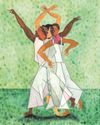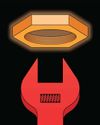
“Anything but Simple: Gift Drawings and the Shaker Aesthetic,” at the American Folk Art Museum, is a splendidly offbeat way to celebrate our country’s favorite strict-yet-serene religious splinter group. More traditional festivities might include hanging your laundry from wooden clothespins, a Shaker invention; or sweeping your house with a broom, which was given its modern form by Brother Theodore Bates, in 1798; or contemplating the heavenly glory of labor, so long as you do not let your thoughts interfere with the labor itself.
The Shakers came to America two hundred and f ifty years ago. Their founding leader, an Englishwoman named Ann Lee, preached Quaker ideals, like pacifism and gender equality, but added collective ownership, a work ethic to embarrass Balzac, and, trickiest of all for a utopia trying to grow, celibacy. Shaker missionaries recruited eloquently, and by the middle of the nineteenth century thousands of believers lived in villages as far south as Florida. Today, the religion has a grand total of two members—not that expansion is the only measure of success. No society chooses its legacy, and the fact that “Shaker” never became a slur like “Puritan” or a punch line like “Amish” has a lot to do with the slender, unembellished loveliness of their furniture. Shaker chairs are among the few art works that I would describe as tenderly severe. Looking at one hurts my back and soothes every other part of me.
This story is from the {{IssueName}} edition of {{MagazineName}}.
Start your 7-day Magzter GOLD free trial to access thousands of curated premium stories, and 9,000+ magazines and newspapers.
Already a subscriber ? Sign In
This story is from the {{IssueName}} edition of {{MagazineName}}.
Start your 7-day Magzter GOLD free trial to access thousands of curated premium stories, and 9,000+ magazines and newspapers.
Already a subscriber? Sign In

ART OF STONE
\"The Brutalist.\"

MOMMA MIA
Audra McDonald triumphs in \"Gypsy\" on Broadway.

INTERNATIONAL AFFAIRS
\"Black Doves,\" on Netflix.

NATURE STUDIES
Kyle Abraham's “Dear Lord, Make Me Beautiful.”

WHAT GOOD IS MORALITY?
Ask not just where it came from but what it does for us

THE SPOTIFY SYNDROME
What is the world's largest music-streaming platform really costing us?

THE LEPER - LEE CHANGDONG
. . . to survive, to hang on, waiting for the new world to dawn, what can you do but become a leper nobody in the world would deign to touch? - From \"Windy Evening,\" by Kim Seong-dong.

YOU WON'T GET FREE OF IT
Alice Munro's partner sexually abused her daughter. The harm ran through the work and the family.

TALK SENSE
How much sway does our language have over our thinking?

TO THE DETECTIVE INVESTIGATING MY MURDER
Dear Detective, I'm not dead, but a lot of people can't stand me. What I mean is that breathing is not an activity they want me to keep doing. What I mean is, they want to knock me off. My days are numbered.